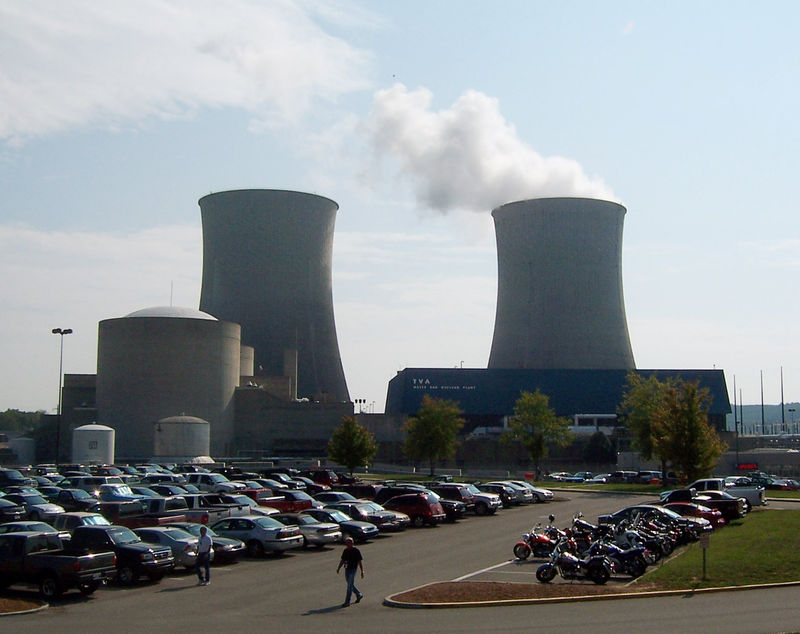By Scott DiSavino
(Reuters) - The U.S. nuclear power industry is facing an uphill battle to hang onto its share of the country's electricity production, with some projecting a worst-case scenario where half of the nation's 99 nuclear reactors could shut over the next couple of decades.
Nuclear power looked to be on the verge of a renaissance about a decade ago. But a surge in domestic natural gas production, billions of dollars in cost overruns on new projects, Japan's Fukushima accident in 2011, and multiple plant closures have the industry on its heels again.
The U.S. Department of Energy (DOE) expects nuclear's percentage of the power mix to drop to 11 percent by 2050 from the current 20 percent, and many reactors to close. A DOE study in August pointed to increased natural gas production as the biggest factor hampering competitiveness in nuclear power.
"Up to half of the currently operational nuclear capacity could be at risk of early retirement in the next decade or two due to low power prices and rising costs," said Dana Lazarus, senior analyst in North American power at PIRA Energy Group, a unit of S&P Global Platts.
Nuclear providers believe they should be paid more for electricity they sell because the power is cleaner than natural gas and coal and more reliable than wind and solar. But gas and renewable producers oppose higher payments for nuclear, which they see as an expensive subsidy to an uncompetitive industry.
"We're not seeking a (government) subsidy," said Joseph Dominguez, head of governmental and regulatory affairs and public policy at top nuclear power producer Exelon (N:EXC). "We're selling a premium product."
The greatest threat is in deregulated states like New York, Illinois and Pennsylvania, where providers, known as merchant reactors, compete against gas and renewable power generators. In regulated states, operators recoup expenses through costs passed on to ratepayers.
In the past five years, operators have shut six reactors amid stagnant electricity demand and low natural gas and power prices, and plan to shut another six reactors in deregulated states over the next five years, in part because they cannot compete with gas-fired plants.
Most states in the U.S. Northeast and Midwest are deregulated. Merchant plants receive the same money for energy they sell as gas-fired and renewable plants, which are less expensive to operate.
"There is a lot the federal government could do to assist troubled merchant nuclear reactors ... the question is whether they will do enough, soon enough to make a difference," said Paul Patterson, energy analyst at Glenrock Associates in New York.
The Trump administration is keen to maintain leadership in the industry, which supports an estimated 475,000 direct and indirect jobs, according to the DOE. The August study called for incentives to boost so-called baseload plants, like nuclear and coal, which run continuously to meet minimum power needs as opposed to wind and solar power.
The industry appeared on the cusp of a rebound about a decade ago, when new plants were commissioned, including projects in South Carolina and Georgia. They were the first U.S. nuclear construction projects to commence since the Three Mile Island accident in 1979.
But cost overruns and delays led the owners of South Carolina's V.C. Summer project to abandon construction in July. Now Southern Co's (N:SO) plant in Vogtle, Georgia is the only nuclear plant currently under construction in the United States.
KEY TO EMISSIONS REDUCTION
For many states, keeping nuclear plants running is key to long-term efforts to reduce greenhouse gas emissions. New York and Illinois in 2016 established financial credits for nuclear reactors for emissions-free power.
The programs, known as zero emissions credits, encourage operators to invest by forcing utilities to buy credits from some nuclear operators. This may stabilise operations in those states for some time, but PIRA's Lazarus said the solution is a short-term one, and if the rules are not extended, "the plants could be at risk of closure again."
Exelon had threatened to shut some reactors in both states before the credits were introduced. The firm says it plans to shut its money-losing unit at Three Mile Island in Pennsylvania in 2019 unless it gets help from that state.
Nuclear operators in other deregulated states are lobbying for credits similar to New York and Illinois. Legislation has been considered in Pennsylvania, Connecticut and Ohio, but no bills have been passed.
Power generators such as NRG Energy Inc (N:NRG), Dynegy Inc (N:DYN) and Calpine Corp (N:CPN), who run mostly gas-fired power plant fleets, are suing to overturn the New York and Illinois rules and lobbying to prevent more states from establishing similar programs.
Exelon is the only company with reactors that qualified for zero emission credits in New York and Illinois. Rather than having states put money in the "hands of a single company," NRG VP and Deputy General Counsel Abraham Silverman said the right solution is for broader reform of markets involving compensation to certain power generators that provide reliability to the electrical grid.
The New York Public Service Commission estimated its nuclear credit programme would cost about $2.8 billion over 12 years. But opponents say it will be more expensive. New Yorkers for Fair Energy, a consumer group, called it a "backroom deal," saying it will cost ratepayers $7.6 billion over 12 years.
